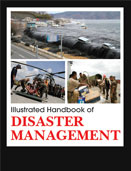Handbooks

Disaster management is defined as the organization and management of resources and responsibilities for dealing with all humanitarian aspects of emergencies, in particular preparedness, response and recovery in order to lessen the impact of disasters. This illustrated handbook presents an analytical critique of the interrelated, multidisciplinary issues of preparedness, response, and recovery in anticipating and rebuilding from disasters.
A disaster is a sudden, calamitous event that seriously disrupts the functioning of a community or society and causes human, material, and economic or environmental losses that exceed the community?s or society?s ability to cope using its own resources. Though often caused by nature, disasters can have human origins. Natural Hazards (and the resulting disasters) are the result of naturally occurring processes that have operated throughout Earth?s history. Natural hazards are caused either by rapid or slow onset events which can be geophysical (earthquakes, landslides, tsunamis and volcanic activity), hydrological (avalanches and floods), climatological (extreme temperatures, drought and wildfires), meteorological (cyclones and storms/wave surges) or biological (disease epidemics and insect/animal plagues).
Illustrated Handbook of Disaster Management presents a comprehensive understanding of the disaster management including the different sources of risk and vulnerability. It also focuses on multidisciplinary strategies aiming to reduce the impact of natural and technological disasters. In contemporary academia, disasters are seen as the consequence of inappropriately managed risk. These risks are the product of a combination of both hazards and vulnerability. Hazards that strike in areas with low vulnerability will never become disasters, as in the case of uninhabited regions. Risk is characteristic of the relationship between humans and geologic processes. The risk from natural hazards, while it cannot be eliminated, can, in some cases be understood in such a way that we can minimize the hazard to humans, and thus minimize the risk. To do this, we need to understand something about the processes that operate, and understand the energy required for the process. Then, we can develop an action to take to minimize the risk. Such minimization of risk is called hazard mitigation. Although humans can sometimes influence natural disasters, other disasters that are directly generated by humans, such as oil and toxic material spills, pollution, massive automobile or train wrecks, airplane crashes, and human induced explosions, are considered technological disasters, except when they occur as a secondary result of a natural disaster. Vulnerability refers the way a hazard or disaster will affect human life and property. In general, less developed countries are more vulnerable to natural hazards than are industrialized countries because of lack of understanding, education, infrastructure, building codes, etc. Risk and vulnerability can sometimes be reduced if there is an adequate means of predicting a hazardous event.
The Illustrated Handbook of Disaster Management brings to the reader a comprehensive coverage of the issue of disaster management. With this book, you will be able to understand about medicinal plants with greater assurance. The book enables student to learn